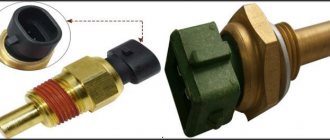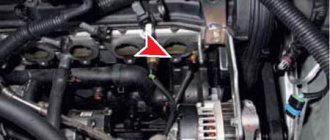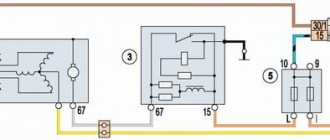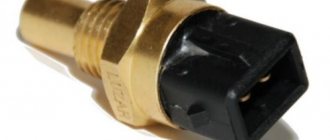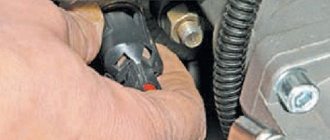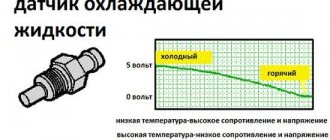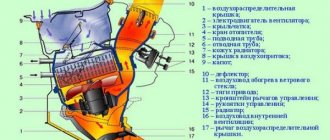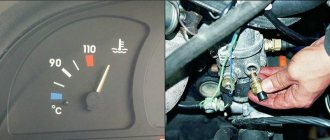Drain the coolant from the cylinder block (see Replacing the coolant).
Remove the wire from the sensor.
Using a 21mm spanner, unscrew the temperature sensor.
Lubricate the threaded part of the new sensor with sealant and tighten the sensor with a torque of 15–20 N·m (1.5–2 kgf·m).
The lifespan of a Niva SUV engine largely depends on how efficiently the VAZ-2121 cooling works. After all, overheating is the first enemy of the power unit, leading to expensive repairs.
This is why the serviceability of the components and elements of the cooling circuit is so important. In order to be able to service them and identify malfunctions, you need to understand what the circuit consists of and how the Niva’s cooling functions.
Symptoms of a malfunctioning knock sensor
As with any other breakdown, if the element in question fails, the car will naturally begin to “act up.”
The main symptoms of a malfunction are:
- Tangible loss of engine power. The car frankly begins to work “tightly”, obstacles may arise when transporting goods and passengers, also when driving “uphill”. This phenomenon becomes especially noticeable if you “accelerate” at idle, the engine will respond very sluggishly to the pedal.
- The car accelerates very sluggishly. Such consequences follow from the previous paragraph and are also quite prominent. It should be kept in mind that complete loss of acceleration can let the car owner down at a crucial moment and lead to unpredictable consequences.
- Increased fuel consumption. This is due to the fact that the electrical control unit does not regulate the ignition angle level.
- Lots of smoke from the exhaust. Naturally, the occurrence of a huge amount of exhaust can be explained by a huge number of defects, but this factor should not be ignored.
- Manifestation of the detonation effect in the engine. The most striking sign is that it is worth paying attention to how efficient this motor element is.
- Check indicator is on. It is also an indicator that indicates many probable defects, but if at least one of the reasons listed above is mixed with the indicator’s lighting, it will be possible to do even without expensive diagnostics.
Repairing a car generator: causes of malfunction, diagnosis of breakdowns
Knock sensor Niva 21214: where is it located, replacement
The knock sensor on the Niva 21214 is a special device used to detect and prevent possible detonation of an internal combustion engine during operation.
Many people are interested in where this sensor on the Niva -21214 car. It is located next to the oil filter. Below is a table that shows the most common models of knock sensors used in the Niva -21214 car, as well as their cost.
Knock sensor Cost, in rubles
| DD Lada Kalina/ Priora/Vesta, VAZ | 360 |
| DD Eng. dv. analogue 18.3855,0261231046 VAZ | 340 |
| DD Lada Kalina/ Priora/Vesta, VAZ | 390 |
READ Where is the Crankshaft Sensor located Nissan Primera P12
There are other models of sensors used on the Niva- 21214 injector . The car owner can independently decide which device he will need and purchase it.
Verification methods
It is easy to check the inoperability of the DD yourself without dismantling it by conducting preliminary testing.
How to do it:
- put the engine at idle speed (about 2000 rpm);
- lightly tap with a hammer near the sensor.
A drop in engine speed (which will be audible) will indicate the serviceability of the part. If the speed remains unchanged, then the piezoelectric element is tested additionally. To do this, the DD will need to be removed by unscrewing the mounting bolt and disconnecting the block.
Then use a voltmeter or multimeter.
Diagnostics Niva 21214 with a fake ECU
The procedure is as follows:
- connect the tester to the DD contacts;
- set constant voltage mode;
- Using light taps on the sensor , monitor the meter readings.
Voltage fluctuations of up to 0.2 volts are a sign of the operating condition of the DD. If there are no voltage surges, it means it is damaged and must be replaced.
Self-replacement of the temperature indicator sensor
Replacing the coolant temperature gauge sensor on a Chevrolet Niva with your own hands is presented step by step below.
- Disconnect the on-board network.
- Remove the protective cover from the meter.
- Disconnect the terminal from which the sensor wire comes.
- Loosen the meter. To do this, you will need a key “21”.
- Unscrew the loose gauge by hand. Remove the sensor.
- Install the new meter in the reverse order of removal.
Price and article
Below is a table with prices for knock sensors for the VAZ 2121 from manufacturers that have proven themselves well in the market.
| Manufacturer | vendor code | ) |
| LADA (original) | 21123855020 | 200-400 |
| "Road map" | 21123855020 | 250-360 |
| Fenox | SD10100O7 | 200-400 |
| ERA | 550489 | 300-400 |
| Decaro | 2112-3855020 | 380-500 |
Symptoms of sensor failure
As already noted, damage can be determined visually. If the knock sensor is faulty, it will affect the performance of the entire vehicle.
Among the most common symptoms indicating a breakdown in the knock sensor are:
- Reduced engine power. Compared to ordinary situations, it will be quite noticeable. So, for example, when operating a car when transporting goods or passengers, the movement of the vehicle will be difficult, the engine will practically stop responding to the accelerator pedal.
- Increasing the length of acceleration. Basically, this symptom is considered a consequence of the previous point.
- Increased fuel consumption. This is explained by the fact that the engine control unit ceases to control the ignition angle level.
- Smoky exhaust. A large amount of smoke from the car's exhaust pipe can signal a problem. However, such a symptom may not always be associated with a malfunction of the knock sensor.
- The occurrence of detonation effect in the internal combustion engine. A fairly striking sign that should serve as a signal to the car owner about the necessary replacement.
Also, symptoms of a motor failure include a lighted indicator on the dashboard. The “Check-engine” icon can indicate several types of breakdowns, but it is recommended to check the knock sensor first.
Removing the crankshaft position sensor
The sensor provides the controller with information about the rotation speed and angular position of the crankshaft.
The sensor is of the inductive type and reacts to the passage of the teeth of the drive disk, combined with the generator drive pulley, near its core.
The teeth are located on the disk at 6˚ intervals.
To synchronize with TDC of the pistons of cylinders 1 and 4, two teeth out of 60 are cut off, forming a cavity.
When a depression passes by the sensor, a so-called synchronization reference pulse is generated in it.
The installation gap between the core and the tops of the teeth should be within 1±0.4 mm.
When the master disk rotates, the magnetic flux in the magnetic circuit of the sensor changes - alternating current voltage pulses are induced in its winding.
Based on the number and frequency of these pulses, the controller calculates the phase and duration of the pulses to control the injectors and ignition coil.
Removing and checking the sensor
1. Turning off the ignition, disconnect the sensor connector.
2. Use a Phillips screwdriver to unscrew the sensor mounting screw.
3. Remove the sensor from the camshaft drive cover bracket
4. The resistance of a working sensor should be in the range of 550–750 Ohms
Install the sensor in reverse order.
How to check the functionality of the sensor
The knock sensor, like other devices installed in the car, tends to periodically fail. This can be caused by various reasons, and often a minor breakdown can be accompanied by a complete failure of such an important component as the engine.
Among the most popular reasons for failure of the knock sensor are:
- wire break;
- insulation damage;
- breakage of the shielding braid;
- problems in the operation of the sensor itself;
- breakdowns in the software or hardware of the internal combustion engine control unit.
READ Absolute Pressure Sensor Renault Logan Symptoms of Malfunction
Checking the knock sensor will allow you to diagnose the malfunction. This is carried out using special measuring instruments or through visual inspection of the device.
So, for example, if there is a suspicion that a short circuit has occurred during the operation of the sensor, you will need to turn off the ignition and disconnect the device from the electronic control unit (ECU). Only after this will it be possible to begin checking the structure using an ohmmeter.
Sometimes the functionality of the wiring connected to the sensor is checked using a voltmeter. This is done with the ignition on. The device measures the indicators between the socket contacts and ground.
the sensor itself using a multimeter. To do this, during testing, you should create artificial vibration by knocking on the device body. If the device data does not change, it means the element has failed.
Possible faults
To avoid problems with engine overheating, it is necessary to monitor and maintain the Niva’s cooling system.
You should check the antifreeze level in the expansion tank more often. Due to the reliability of cooling, there are not many malfunctions in it:
- When the car heats up to maximum in any weather, and the main radiator pipes are cold, the thermostat has broken. The element is not repaired, only changed.
- Electric fans turn on at random, including when the engine is cold, but if they overheat, they may not start. This means that the sensor transmitting temperature data to the controller has failed and must be replaced.
- When the indicator on the panel gives inaccurate data or does not show the temperature, you need to change the second sensor located in the cylinder head.
- The fluid level in the tank is constantly decreasing. It is necessary to look for and eliminate leaks in the pipes or in one of the radiators.
It is important to periodically check for play in the water pump shaft. Its appearance indicates wear of the bearing; it is necessary to change the pump as soon as possible.
VAZ-2121, 21213-15, 2129-31 are a famous family of SUVs that have gained enormous popularity from the first day the production model appeared in 1977. The VAZ-2121 Niva is a basic model, which is based on a monocoque three-door station wagon and a transmission with permanent all-wheel drive.
Knock sensor Niva 21214
The knock sensor on the Niva 21214 is a special device used to detect and prevent possible detonation of an internal combustion engine during operation.
Many people are interested in where this sensor is located on the Niva-21214 car. It is located next to the oil filter. Below is a table that shows the most common models of knock sensors used in the Niva- 21214 , as well as their cost.
Knock sensorCost, in rubles
| DD Lada Kalina/ Priora/Vesta, VAZ | 360 |
| DD Eng. dv. analogue 18.3855,0261231046 VAZ | 340 |
| DD Lada Kalina/ Priora/Vesta, VAZ | 390 |
There are other models of sensors used on the Niva -21214 injector . The car owner can independently decide which device he will need and purchase it.
Location of temperature sensors
The coolant temperature indicator sensor is screwed directly into the hole in the cylinder head. It can be seen if you look at the power plant from the left side.
The DTOZH is located in the coolant outlet line. It is inserted into the front pipe of the water jacket.
To see where the outside air temperature sensor is located, you need to look under the front bumper. The meter is located behind the lower right corner of the license plate. Without removing the bumper, the sensor can be seen through the hole located near it.
Replacing the sensor
If a malfunction is detected in the operation of the knock sensor, the owner of Niva -21214 must proceed to repair or replace the device. You can perform the procedure yourself by deciding where the sensor and preparing the necessary tools before starting work. These include:
- screwdriver;
- wrench;
- 13 mm head.
All VAZ Sensors Location. All VAZ NIVA drivers need to know this. DPS, DMRV, DPKV, DPRV, IAC
You will also need to stock up on a new knock sensor.
The procedure for replacing the DD is as follows:
- The car owner places the vehicle in a convenient position for work.
- Turns off the engine and disconnects the terminals from the battery. This is necessary for the safety of further work.
- After this, you will need to remove the wire from the sensor and unscrew the bolt that secures it to the engine. The procedure is performed using previously prepared instruments.
- Once this is done, you can replace the old knock sensor with a new one. It will also need to be secured with a bolt (no need to tighten it too much) and a terminal attached.
- The final step involves reassembling the car structure in reverse order.
After the procedure for replacing the knock sensor is completed, the owner of the Niva- 21214 will need to start the engine several times to check the functionality of the sensor and the entire car as a whole. First of all, you should pay attention to the symptoms of breakdown that were indicated above. Naturally, they shouldn't exist.
READ Timing belt replacement for Ford Kuga 2
Based on this, we can conclude that the process described above is not complicated, and to replace the sensor it is not at all necessary to contact a service station. However, in order to protect yourself from possible malfunctions, you should regularly diagnose and maintain all components of the car.
Location and electrical diagram
The fuse block (hereinafter referred to as the fuse block), unlike traditional models of the domestic automobile industry, is located in the vehicle interior. In particular, it is located on the driver's side under the steering wheel. If any electrical circuit element in a car stops working (lamps, interior lights, heater, power windows), then car owners first check the power supply elements. As a rule, the problem is resolved by replacing the fuse.
What does the power supply circuit itself look like? This question may be of interest to Niva owners. Below we will look at the electrical circuit of the unit with a description of all the components responsible for the operation of certain devices in the car.
In accordance with the diagram, we will consider the meaning of the BP elements. This electrical circuit is universal for all Niva cars.
Electronic engine control unit (ECU)
An ECU is a kind of computer in a car; it is in this device that the entire operation of the internal combustion engine is corrected. All sensors that are installed in the car transmit readings specifically to this unit, and based on the readings, it makes changes to the operation of the engine, which affects both the engine speed and its consumption.
Signs of a DMRV malfunction:
- Loss of vehicle dynamics;
- Increased fuel consumption;
- Unstable idling (speeds fluctuate);
- Difficulty starting the engine when the engine is warm;
Brake pedal sensor
The brake pedal sensor is installed on the pedal assembly under the steering column of the VAZ 2121. In cars without the E-GAZ system, it is only responsible for turning the brake lights on and off. In cars that have an electronic throttle and therefore an electronic gas pedal, this sensor affects the operation of the pedal. If the brake sensor breaks down, the gas pedal stops working.
Symptoms of ECU malfunction:
There can be a huge number of signs of malfunction of this unit, because signs of failure of one sensor may even indicate failure of the unit.
Coolant temperature sensor (DTOZH)
The DTOZH on Niva is installed in the cylinder head outlet pipe. The coolant temperature sensor is a fairly simple element in its design. The sensor is based on a thermistor, which changes its resistance as the temperature changes.
One of the functions of the sensor is to start the electric engine cooling fans when the coolant temperature threshold is reached. The sensor is also responsible for starting the engine in cold weather; according to the coolant temperature readings, the electronic control unit forms the fuel mixture necessary for more proper warming up of the car engine. This can be replaced by the presence of high warm-up speeds at the moment of starting the internal combustion engine.
Signs of DC malfunction:
- Increased fuel consumption;
- Loss of vehicle dynamics;
- Poor engine starting;
Sources:
https://zapchasti.expert/datchiki/datchik-detonacii/datchik-detonacii-niva-21214.html https://enginehack.ru/datchiki-niva/
Vehicle cooling network design
The cooling system of the VAZ Niva is quite effective and has undergone virtually no changes since its creation. It includes the following units and elements:
Temperature control in the Niva engine cooling network is carried out in different ways. In the carburetor model VAZ-21213, a sensor is built into the cylinder head, connected to the temperature indicator on the dashboard. On the VAZ-21214 model, where the fuel is supplied by an injector, there is a second sensor mounted in the pipe on the cylinder head. It is connected to a controller that prepares the fuel mixture depending on the heating of the power unit and turns on the fans.
There are 2 more differences in the cooling design of engines with a carburetor and an injector:
- on cars with direct fuel injection, 2 electric fans are installed on the radiator instead of 1 mechanical;
- The heating pipes for the lower part of the carburetor in model 21214 provide heating for the throttle body.
In VAZ-2131 Chevrolet Niva cars, the cooling system is generally similar to a regular Niva with an injector. The VAZ-2131 heater radiator is not equipped with a tap, which is why antifreeze flows through it all year round.


